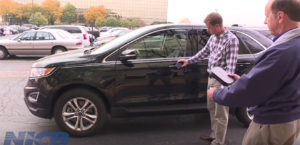

Insurance crime investigators recently went on a crime spree, breaking into vehicles and stealing them.
It was all part of an effort to draw attention to technology that the National Insurance Crime Bureau (NICB) says is being used to not only unlock and open vehicles, but to also start and steal them. Investigators at the industry-backed NICB recently got their hands on one of the nefarious devices and decided to try it out for themselves.
The organization has been warning about the devices for several years, ever since thieves were spotted on security cameras across the country using an unknown device.
NICB says it purchased one of the devices through a third-party security expert from an overseas company. The group says the device was originally developed by engineers to give manufacturers and other anti-theft organizations the ability to test various vehicles’ systems. Called a “Relay Attack” unit, the particular model NICB bought only works on cars and trucks that use a keyless remote and a push-button ignition.
NICB tried out the device at different locations over a two-week period on 35 different makes and models of cars, SUVs, minivans and a pickup truck. The insurance crime watch group partnered with one of its member companies, CarMax, a large used car dealership. The investigators also tested it on vehicles at a new car dealership, an independent used car dealer, an auto auction and on NICB employees’ vehicles and others owned by private individuals.

According to NICB, its testers were able to open 19 (54 percent) of the vehicles and start and drive away 18 (51 percent) of them. Of the 18 vehicles that were started and driven away, 12 were then restarted using the device.
NICB says experts believe there are a number of different devices being offered for sale to thieves. Some use different technology and may work on different makes and models and ignition systems. More expensive models may have a greater range and better capabilities for opening and starting a vehicle.
“We’ve now seen for ourselves that these devices work,” said NICB President and CEO Joe Wehrle. “Maybe they don’t work on all makes and models, but certainly on enough that car thieves can target and steal them with relative ease. And the scary part is that there’s no warning or explanation for the owner. Unless someone catches the crime on a security camera, there’s no way for the owner or the police to really know what happened. Many times, they think the vehicle has been towed.”
Wehrle says it’s important for law enforcement officers to be aware of this threat and be on the lookout for thieves who may be using the technology.
According to NICB’s Chief Operating Officer Jim Schweitzer, who oversees all NICB investigations, vehicle manufacturers must continue their efforts to counter the attacks on anti-theft technology.
“Vehicles are a valuable commodity and thieves will continue to wage a tug of war with the manufacturers to find a way to steal them,” said Schweitzer. “Anti-theft technology has been a major factor in reducing the number of thefts over the past 25 years. The manufacturers have made tremendous strides with their technology, but now they have to adapt and develop countermeasures as threats like this surface.”
NICB advises drivers to always lock their vehicles and take the remote fob or keys with them. According to NICB, there were 57,096 car thefts with keys left in the car in 2015, which was a 22 percent increase over the previous year. Over the past three years, this kind of theft has grown by 31 percent.